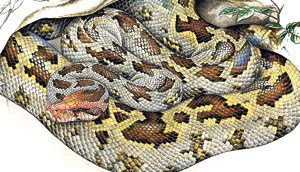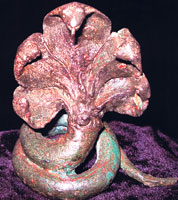It was a mundane day at school – but the excitement mounted with the final clang of the bell indicating that lessons were over. When my father picked me up, the air of expectancy reached unbearable proportions, for there was that glint in his eye and as he stopped halfway on our journey back home and signalled that I peer into the boot of the car, I couldn’t contain my excitement.
 |
| Illustration of the Rock Python |
Fascination……..for lying amidst gunnies in the boot was a richly-speckled python, staring back at me with its beady but mesmerizing eyes. A close encounter with the slithery kind!
That was my birthday present when I turned five. Those were the sixties, when most parents with large families would buy a single book as a gift, unlike now when children are spoilt with the latest technological gadgets.
I did get a book as well, but the python remains etched in my memory as the most exotic and wholly unexpected gift ever received. A lover of animals of any kind, my father had picked up the stunned python, after it had been run over by a vehicle, to be added to our menagerie in Anuradhapura which at different times included a leopard, a sambhur and the usual monkeys, rabbits, dogs, cats, goats and ducks.
Yes, snakes have fascinated and mesmerized humans down the ages of time. It was a serpent that is said to have tempted Eve in the Garden of Eden to persuade Adam to take a bite of the Forbidden Fruit, against the express wishes of God. Greek and Roman tales abound about snakes, with the most horrible image being created in the mind’s eye with the waving and moving snakes on Medusa’s head, a look at which according to myth turned anyone to stone.
Many are the tales inextricably linked to snakes in this part of the world too including Sri Lanka, portrayed in intricate sculptures and paintings. Lord Buddha himself is depicted under the massive but sheltering hood of the King Cobra.
 |
| Anslem de Silva |
Many are also the books written about snakes, but the latest, ‘Snakes of Sri Lanka – A Coloured Atlas’ by famous “snakeman” Anslem de Silva (who gets queries in the form of phone calls and e-mails from all over the country whenever snakes need identification) with beautiful illustrations by Jayantha Jinasena, published by Vijitha Yapa Publications is in a class of its own.
While giving detailed descriptions about both venomous and non-venomous snakes including sea snakes which are usually given short shrift in other documentation and data on snakebite, the twists and turns of snakes in archaeology, history and folklore are woven in expertly to form a comprehensive whole.
The dust cover in stark black contrasted with red and green lettering and a sketch of a Lemapila or Poonai Pambu (Boiga forsteni) tempts the reader to take a peek but it is the inside cover that intrigues him and assures that it is not just a book on snakes but something more. A walk down the corridors of time because “since time immemorial, man has feared, deified, immortalized and marvelled at serpents as is reflected in the use of the serpentine motif in prehistoric art”.
An indication of what is to come is depicted in the border of the title page, a delicate reproduction of the foliage in the granite flight of steps of the Arattana Raja Maha Viharaya, Hinguranketha (1604-34) with the cobra motifs being reproductions from the 3rd to 6th century AC granite guardstones at Anuradhapura.
Little known or for that matter details given scant attention are unearthed……how snakes have adorned not only more intricate art and sculpture in this country but also undated rock paintings by the Veddahs; how ornamental and symbolic vessels with the cobra motif were used in rituals and how snake figures were inscribed in Ola books on witchcraft and the traditional treatment of snakebite.
For the uninitiated, this atlas also documents those who have attempted this kind of foray into “painting snakes to document their colour pattern and scalation” which author de Silva readily agrees is a challenging and creative exercise – from physician Patrick Russell, Joseph B. Fayrer, Colonel Frank Wall, John Davy (one of the first Europeans to research on the venom of Sri Lankan snakes and to test the efficacy of snakestone in traditional treatment) to Sir James Emerson Tennent and Paulus Edward Pieris Deraniyagala (to whom the book is dedicated).
While paying tribute to those who have gone down a similar path, de Silva humbly makes the point that in reviewing the evolution of snake art in the region, especially in Sri Lanka, it is clear that the drawings in this monograph are of better quality and accuracy. This is the first time an effort of this magnitude has been attempted in the country. The large plates, 52 in all, add colour and life to this atlas, making even a child interested in it.
And the effort has not only been laborious and time-consuming but also fulfilling, for as Jinasena says, “Although Anslem de Silva and I conceived the idea of illustrating a monograph on the snakes of the country with paintings way back in 1994, it bore fruit over 15 years later”.
Herpetologist de Silva has many publications (including ‘A Colour Guide to Snakes of Sri Lanka published in England) to his credit, having been interested in the slimy, slithery kind since he was seven. He has studied many ecosystems across the country and also organized several national and international herpetological conferences.
 |
| The polycephalous cobra (bronze) Anuradhapura 6th Century AC used as a motif in the border of the title page |
Complementing de Silva’s skills to make the atlas a cut above other publications is Jinasena, a protégé of the late Gate Mudaliyar A.C.G.S. Amarasekera and one of the country’s foremost wildlife artists who uses live specimens as models to produce realistic images……... “before drawing the preliminary sketches, the snakes were placed inside large glass tanks with leaf litter for some time, until the animals relax and become calm. The snakes were carefully observed and their different postures sketched. Finally, the sketches showing the most natural posture were selected for detailed drawings and paintings. Each painting took approximately 10 to 15 days.”
A chapter that will definitely grip the reader will be the ‘Folklore and Proverbs’ linked to snakes, which has been collated after lengthy discussions with Buddhist monks, village elders, traditional snakebite physicians and astrologers and also delving into literature.
Some of the interesting snippets are: many believe that the fat of the python contains quick healing substances and if it is cut into two or suffers from a deep wound will heal quickly….therefore, if python oil is rubbed into a deep wound, it will heal rapidly; wearing the ‘special’ vertebrae of a python around the waist will cure rheumatic pains…..to select the special vertebrae one has to bury a dead python length-wise and sow any quick growing grain on the soil along that……the special vertebrae are found where the seeds do not germinate; Boiga forsteni (Forsten’s cat snake or le mapila) is believed to possess the vampire or blood sucking habit, with seven of them descending from the roof at night, lowering themselves in succession by hanging on to one another……the one nearest to the sleeping human bites the toe and sucks the blood of the victim and this blood is passed up in turn to the seventh snake on the roof…..the victim falls into a deep slumber and by the time the snakes are sated the victim is dead; and Ptyas mucosa (Rat snake) is considered the meanest of snakes and if a person is bitten by it, other snakes, mainly the cobra, will not bite that particular individual.
Whoever assumed that caste was only among humans is proven wrong with the atlas pointing out that colour variations among cobras have since ancient times put them into different castes -- the albino being the Raja Kule nagayas or of the Royal caste, living in palaces and feeding on Babila flowers and not on rats or frogs; the yellowish white Bamunu Kule nagayas (Brahmin caste cobras) with additional markings (Polyocellata) on the hood live in temples and feed on fragrant flowers; the Velenda Kule nagaya (Merchant caste cobra) and the Sudra or Govi Kule nagaya (farmer caste cobra) are light reddish brown in colour and live in dens and feed on rice and sweetmeats; the ‘low caste’ cobras, the Berava Kula nagaya (tom-tom beater caste) and the Garandi Kula nagaya (Rat snake caste cobra) are black and feed on rats and frogs.
De Silva, however, dispels these myths with observations such as “Polyocellata cobras in my collection fed only on day old chicks, rats and frogs even though there were plenty of Babila flowers in the cage”, adding that the separation of cobras into castes can be explained more scientifically as separation into colour variations.
More nuggets of information are contained in the atlas encompassing snakes in sorcery as well. Of 18 pillies (charms) where demons assume visible forms to inflict harm on a targeted person, one is the Nâga pilli (cobra pilli), where the charmed cobra will bite only that particular person intended to be killed.
The snakes of the world are grouped into 19 families, according to the atlas, and 10 of them comprising 101 species are found in Sri Lanka. All 101 of them adorn this atlas, making it not only a collector’s item but even useful around any home.
‘Snakes of Sri Lanka – A Coloured Atlas’ priced at Rs. 10,000 is available at all Vijitha Yapa bookshops, with two autographed copies being available with author Anslem de Silva who may be contacted on phone: 0712748411 or e-mail: kalds@sltnet.lk |
